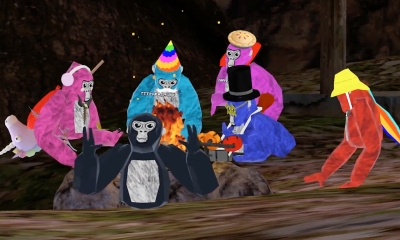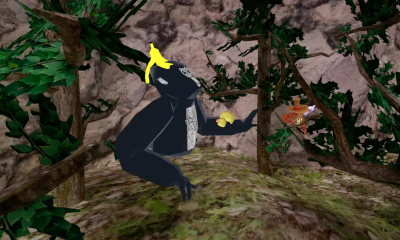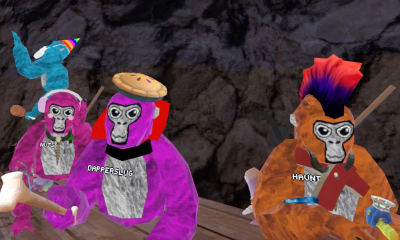Gorilla Tag
When I first stepped into the virtual world of Gorilla Tag, I felt like I had entered a completely different realm. My journey began with a sense of wonder that was hard to describe. The immediate immersion was striking; I noticed how every movement and action in the game compelled me to use my own body in unexpected ways. As I put on my headset and entered the jungle-like environment, I realized that this game was not merely about high scores or simple competition—it was about rediscovering a youthful spirit of adventure. The mechanics were intuitive, yet challenging enough to set my heart racing as I navigated around trees and other obstacles. Each motion of my arms propelled me forward, and every grab or release became an active exploration of my own physicality. I could feel every shift in momentum and each small motion that gradually built into leaps and bounds. It was as if the game invited me to challenge both my physical and mental perceptions of movement in virtual space.
From the very beginning, I appreciated the unique design of the game’s environment. The world felt alive, with its towering trees and intricate network of vines and branches. I marveled at how the developers managed to merge minimalistic, almost childlike, visual aesthetics with sophisticated mechanics that required genuine effort and coordination. The experience was both visceral and engaging—it demanded that I concentrate fully on the task at hand. While traditional gaming relied on buttons and joysticks, Gorilla Tag pushed me to use my arms, incorporating elements of physical exercise into gameplay. I couldn’t help but feel my pulse accelerate as I swung from branch to branch in this digital jungle. This sense of active participation from the very beginning made me realize that this was not just another virtual game, but rather a playground where my own body and instincts were both the controller and the participant.
The game’s initial moments resonated with me on a deeply personal level, calling back memories of outdoor physical activities from my childhood. I was struck by the simplicity yet profound impact of letting go of pretense and engaging in pure, unadulterated fun. Every jump and every swing reminded me of a time when the physical world was the ultimate playground, and digital boundaries did not limit the scope of my imagination. The immersive nature of Gorilla Tag encouraged me to push my limits and explore a virtual territory where my physical coordination was the key to success. With each successful maneuver, I felt a growing bond with this unique digital realm, and I couldn’t wait to see what new challenges lay ahead. The introduction to Gorilla Tag was an exciting interplay between nostalgia and modern virtual reality, setting the perfect stage for the adventure that was yet to come.
Aerial Acrobatics in the Virtual Canopy
Once I had adjusted to the initial thrill of Gorilla Tag, I found myself falling deeper into an environment that redefined the idea of movement and spatial awareness. The mechanics that allowed me to swing, leap, and climb with the grace of an agile primate were unlike anything I had experienced before in digital gaming. I discovered that every deliberate motion of my arms was the catalyst for a cascade of movements that felt both liberating and, at times, challenging. The learning curve was steep, yet immensely rewarding. I vividly recall the first time I successfully vaulted onto a higher branch—a moment filled with a surge of adrenaline and the satisfying realization that I had transcended the limits of a typical gaming experience. The virtual canopy was lush and inviting, filled with pathways and hidden routes, each promising a new level of athleticism and exploration.
This section of the game brought me face-to-face with the intricacies of its control system, which demanded not only precise hand coordination but also a keen sense of timing. The interplay between momentum and direction was crucial here, making every swing a calculated risk. I could feel how my body learned to trust its own instinct, relying on muscle memory as I moved through the intricately designed environment. Every encounter with a branch, every moment of mid-air balance, required me to be hyper-aware of my movements. The satisfaction of nailing a particularly challenging acrobatic sequence was unlike any other gaming triumph I had experienced before. It was as if I was learning a new language—one where my body spoke fluently and elegantly, translating physical effort into digital progression.
While some might liken the experience to a conventional parkour session, the game transformed physical exertion into an art form. I found a serene beauty in the act of leaping from one platform to the next, a beauty that lay in the raw, unfiltered joy of bodily movement. The challenges posed by the environment were tailored perfectly, pushing me to refine my technique and embrace the unpredictability of each swing. Every obstacle became an invitation to explore new methods of overcoming physical limitations, and each mastered movement intensified my connection with the game's world. Engaging with Gorilla Tag in this way allowed me to merge my passion for physical activity with my love for exploration, blending virtual and corporeal experiences into one seamless adventure.
Navigating the Vertical Labyrinth
The next phase of my journey in Gorilla Tag involved a deeper immersion into its vertically oriented labyrinth. I realized early on that the game was not simply about horizontal movement; it was a vertical playground where height and elevation played as significant a role as distance. The sensation of climbing higher into the canopy allowed me to experience the thrill of reaching for the unknown. I found that every leap upward was more than a mere act of physicality—it was a step into an arena where gravity and momentum danced together in perfect unison. As I ascended from ground level into the boughs of towering trees, each step was a challenge that required not only strength but also strategic planning and timing. The game introduced obstacles that demanded creativity and adaptability, reminding me constantly that every climb was an opportunity to master both technique and body coordination.
One of the most fascinating aspects of this vertical navigation was the variety it offered. No two climbs were the same; each new pathway presented its own set of physical puzzles and natural barriers. I vividly recall moments when I reached a ledge that seemed impossible to access at first glance. The solution was often hidden in the physics of the game itself. By carefully adjusting my grip and using the momentum of my body, I could swing around obstacles and propel myself toward higher platforms. This created an environment where every player’s strategy could be uniquely personal. I often spent time experimenting with different techniques, pushing the boundaries of my abilities. It was an exhilarating exercise in trial and error, where every successful maneuver reaffirmed my connection with the dynamic game mechanics.
The design of the vertical challenges in Gorilla Tag also held a certain aesthetic appeal. The interplay of shadows among the foliage, the dappled sunlight that filtered through the treetops, and the soft chime of movement contributed to an immersive clarity that felt almost meditative. At times, I was so captivated by the environment that I lost track of time. The combination of the tactile enjoyment of physical movement and the visual orchestrations of the virtual world created a compelling invitation to explore more, to push further against the gravity that defined my physical limitations. Each new branch I reached or ledge I grasped was a testament to both personal ingenuity and the innovative spirit that lay at the heart of Gorilla Tag.
Unbridled Multiplayer Mayhem
Venturing deeper into the world of Gorilla Tag, I was pleasantly surprised by the rich social fabric that underpinned the gameplay. Unlike many traditional games where multiplayer interactions can sometimes feel forced or secondary, Gorilla Tag placed human connection at its core. When you enter the jungle, you are immediately immersed in a lively community of players, each exhibiting their own unique approaches to movement and competition. I soon discovered that the multiplayer mode was not just about chasing or being chased; it was a playground for creativity and collaboration. The game's design encourages spontaneous interactions that range from exhilarating chases to playful experiments in acrobatic sequences. I often found myself laughing along with my fellow players, sharing nods of approval when a particularly daring move was executed flawlessly.
The true magic of Gorilla Tag’s multiplayer aspect is in its unpredictability. Every session felt like a new adventure, with different players contributing their own skill sets and inventive strategies. In one instance, I partnered with a group of enthusiastic players to orchestrate a series of elaborate swings, navigating complex networks of branches with an almost choreographed grace. There was a palpable sense of camaraderie as we worked in tandem to overcome physical obstacles, each of us contributing to a shared experience that transcended the typical boundaries of online gaming. The social presence in the game enhanced my engagement, transforming each match into a dynamic, vibrant event that was as much about community as it was about competition.
Furthermore, I was struck by the emphasis on fair play and positive interaction. Unlike many gaming environments where competitiveness can sometimes escalate into undesirable behavior, Gorilla Tag maintained an atmosphere of lighthearted fun and mutual respect. Every encounter in the multiplayer space was a learning experience, where I absorbed techniques and strategies from other players while also teaching a few of my own tricks. The experience was not measured solely by wins or losses, but by the creativity and energy that each participant brought to the digital jungle. This innovative integration of physicality with social dynamics created a remarkable sense of belonging, reinforcing that the game was as much about the joy of movement as it was about forging connections with others.
Exhilaration Through Physical Engagement
The moment I started using my body as the primary tool for navigation in Gorilla Tag, I found myself engulfed in a state of pure exhilaration. The game’s mechanics required that I engage every muscle as I prepared myself for each leap and swing. Unlike traditional gaming controls, which frequently depend on the precision of button presses, Gorilla Tag’s bodily mechanics demanded a form of exertion that was both physically challenging and immensely gratifying. I quickly realized that the sense of accomplishment derived from a perfectly executed swing was unlike any feeling I had experienced before in the realm of gaming. The more I played, the more I felt that I was not just participating in a game, but rather embarking on an athletic challenge that was both invigorating and empowering. Every movement was an experiment in balance, coordination, and timing.
This unique interaction with physical exertion presented a dual-layered experience. On the one hand, my body was put to the test in a virtual arena, bringing a novel dimension to the term “exercise.” The sheer effort required to propel myself upward or to change direction mid-swing nudged me to become aware of my physical capabilities in a way rarely prompted by digital entertainment. At the same time, the physicality of the game offered a gateway to mindfulness; each deliberate motion became a meditation in motion. I found a rhythm in the repeated exercise of my swinging arms, where every leap was a celebration of the body’s strength and resilience.
Moreover, the challenges presented by Gorilla Tag were ingeniously crafted to encourage progressive physical engagement. The game evolved continuously, with obstacles that demanded incremental improvements in my athletic performance. I learned to anticipate the consequences of my own momentum, adjusting my techniques as I advanced further into the game’s winding canopy. The interplay between muscle memory and quick-thinking resulted in moments of sheer brilliance, where every successful maneuver filled me with a surge of adrenaline. This physical engagement was the beating heart of the game—an invitation to transform my body into both a controller and an instrument of play. The immersive nature of this experience is something that continues to motivate me with every session, making each encounter a unique blend of exercise and artistry.
Artistry in Digital Aesthetics
One of the facets of Gorilla Tag that truly captivated my attention was its striking aesthetic appeal. The visual design of the virtual jungle was crafted with a blend of simplicity and elegance, capturing the essence of a natural woodland environment without overwhelming the senses. As I navigated the digital playground, I began to appreciate the artfulness behind every vine, tree trunk, and ray of virtual light that filtered through the canopy. The developers used a minimalist approach that allowed the beauty of raw nature to stand in stark contrast to the high-intensity physicality of the gameplay. I often found myself pausing mid-swing, not out of hesitation, but simply to take in the aura of the environment. Layers of foliage, subtle textures, and a delicate interplay of light and shadow created an immersive atmosphere that elevated each movement into an act of performance art.
The visual style of Gorilla Tag, though unadorned in many conventional aspects, spoke volumes about what it aimed to communicate—a return to a primal state of creativity and wonder. The clarity and simplicity of the environment allowed me to focus entirely on the fluidity of my movements, while the ambient backdrop provided a canvas that was both inviting and inspiring. I appreciated the fact that the design did not rely heavily on realistic graphics or hyper-detailed textures; instead, it opted for a stylized representation that evoked the essence of a jungle playground. This artistic choice served to reinforce the game’s underlying philosophy: that the joy of physical expression could be celebrated in its most unrefined and spontaneous form. Each session felt like traversing a hand-painted dreamscape, where the authenticity of raw nature merged seamlessly with the dynamism of my own movements.
The aesthetic decisions made by the creators resonated deeply with me, as they aligned with the idea of embracing simplicity to highlight natural beauty. I often marveled at the ingenious use of color and light to differentiate various zones within the digital jungle. The way sunlight danced on the ground and glinted off branches lent an organic rhythm to the game’s atmosphere, turning every session into an intricate performance of light and movement. It was in these moments of artistic clarity that I came to see Gorilla Tag as much more than a physical challenge—it was a living, vibrant piece of digital art that invited players to become co-creators in its evolving narrative.
Symphony of Sounds and Rhythms
Another dimension that deeply enriched my experience of Gorilla Tag was its masterful use of sound and music. As I moved through its virtual corridors and sprawling jungles, I was enveloped in an ambient soundscape that enhanced every dimension of gameplay. The audio was not intrusive but perfectly attuned to the game’s organic feel. I recall how the subtle rustling of virtual leaves, the gentle creaking of tree branches, and the distant echoes of playful calls from fellow players wove together to form a sensory tapestry that was both calming and invigorating. Each movement I made, be it a swing or a leap, produced a corresponding note in what felt like an ever-changing, improvised symphony. This careful melding of sound with physical activity created a rhythm that seemed to mirror my heartbeat, amplifying the excitement of every action.
While some games rely on repetitive background music that can become monotonous over time, Gorilla Tag continuously adapted its auditory cues to match the environment and activity levels. I found that the sound effects subtly shifted in intensity as I navigated from shaded areas under dense foliage to sunnier, open spaces. There was a dynamic interplay between quiet moments of introspection and bursts of energetic music that coincided with rapid, athletic maneuvers. The audio design felt almost as thoughtfully crafted as the physical movements themselves—it wasn’t simply a background element, but an integral part of the experience. Each sound served as a gentle cue or a burst of encouragement, reminding me that my actions were part of an elaborate dance where every note had its place.
Furthermore, the soundscape of Gorilla Tag provided a tactile dimension to the virtual world that deepened my overall immersion. I remember instances when the layered audio cues allowed me to sense the presence of other players or the proximity of a challenging sequence ahead. It was as though the game communicated its secrets through these auditory whispers, guiding me onward and upward through its intricate maze. The harmony between sound and movement elevated the entire experience, transforming what might have been a simple game into a well-orchestrated performance. Listening to the evolving symphony of sounds, I felt more in tune with my virtual surroundings than I ever had in previous digital adventures, a realization that instilled both excitement and a meditative calm as I continued exploring.
Embracing the Unpredictable: Social Interactions
My journey through Gorilla Tag was not a solitary adventure but a vibrant tapestry of spontaneous social interactions. The game’s design created a dynamic space where every player had the opportunity to contribute to an unpredictable and lively environment. I never knew what to expect when I encountered new players in the midst of the jungle’s free-form race for movement and agility. Each participant brought their own style, energy, and ingenuity to the game, making every session feel fresh and full of surprises. I found that the shared experiences in this energetic playground often led to a rapid, unspoken camaraderie. When I swung across a challenging gap or executed an unpredictable maneuver, I could feel the admiration—or sometimes the playful challenge—from others in the vicinity. These interactions were spontaneous, joyful, and deeply engaging, as if every moment in the game was an opportunity to collaborate or compete in equal measure.
The social aspect of Gorilla Tag resonated with me on multiple levels. On one hand, there was a strong sense of competition that pushed me to continually improve my own performance, urging me to refine my timing and technique with every attempt. On the other, the cooperative moments—where players shared tips, strategies, or even simple words of encouragement—helped foster an environment of mutual respect and shared joy. I vividly recall times when a particularly challenging situation would bring together a small group of us, each offering creative solutions or simply enjoying a moment of shared triumph once the challenge was overcome. The unpredictability of these interactions made each game session unique, enriching the experience beyond a mere test of physical prowess.
What struck me most was the organic nature of these social exchanges. There were no scripted dialogue systems or forced interactions; everything felt real and unscripted. The mix of competitive drive and friendly banter created a vibrant energy within the game, turning each session into an evolving narrative of human connection and athletic ambition. I found that these moments of interaction were as memorable as the physical challenges themselves. The landscape of Gorilla Tag was not defined solely by its digital architecture, but by the human spirit that coursed through every swing and leap. In that way, each social encounter served to remind me that the game was a living, breathing community, one where every interaction played a part in crafting an entirely unique adventure.
Innovative Mechanics and Boundless Possibilities
Gorilla Tag captivated me not only with its physical challenges and stunning environment but also with its innovative mechanics that broke the mold of traditional gaming. As a player, I was continuously impressed by the thoughtful design decisions that allowed a simple concept to transform into something far more intricate and engaging. The game’s reliance on natural, arm-driven movement was a refreshing departure from conventional control schemes, turning every gesture into an opportunity to shape my virtual destiny. I was drawn into a cycle of trial, error, and eventual mastery that constantly rewarded experimentation. With each new session, I discovered more of the hidden mechanics—how to use momentum from a well-timed swing, how to change trajectory in mid-air, and how each slight adjustment in movement could yield entirely new outcomes in performance. The potential for creative expression in such an environment seemed limitless, and I began to see Gorilla Tag not simply as a game, but as an open-ended playground.
The design of the game encouraged exploration and experimentation, challenging me to develop my own unique style of movement that blended athleticism with imaginative strategy. I spent considerable time perfecting techniques that allowed me to navigate through the digital jungle more fluidly, learning through incremental progress and occasional setbacks. These setbacks served as learning moments that opened up further possibilities, igniting a desire to continually adapt and improve. There was a profound sense of satisfaction in discovering that even the smallest change in how I used my arms could result in substantial differences in performance, a realization that made every movement feel personally tailored—a signature of individuality and creativity. The game served as a reminder to me that innovation often lies in the simple act of rethinking the way I use my body in a virtual setting.
The mechanics of Gorilla Tag were designed to be intuitive and accessible yet remained challenging as one sought mastery. The balance between straightforward controls and complex, emergent gameplay was a testament to the ingenuity of its developers. Each session unraveled new opportunities for personal expression, making every match a canvas on which to paint my own narrative of athletic adventure. Whether I was exploring new routes or engaging with other players in creatively coordinated sequences, the mechanics consistently inspired me to think outside the conventional boundaries of gameplay. The sense of possibility in each session was incredibly empowering, as it made me realize that within the digital confines of the jungle, I had an entire world of unique movements and innovative techniques awaiting discovery. The experience reminded me that imagination and physicality are intrinsically linked, and that innovative mechanics can transform even a simple concept into an extraordinary adventure.
Exploration of the Digital Wilderness
Immersing myself further into the world of Gorilla Tag, I found that the game was much more than a test of physical skills—it was an invitation to explore a vibrant, ever-changing digital wilderness. From the moment I navigated beneath towering virtual trees and moved through a labyrinth of intertwining branches, I felt a strong connection to an environment that was as wild as it was thoughtfully constructed. The interplay between open spaces and compressed, intricate pathways created a sense of mystery and excitement at every turn. In my early explorations, I cherished moments when a seemingly insignificant pathway revealed a hidden alcove or a higher vantage point. Each segment of the virtual jungle unfolded gradually, inviting me to uncover its secrets, feel its textures, and experience its challenges at my own pace.
My days spent in Gorilla Tag were filled with an almost meditative exploration of the environment. I discovered that the world was meticulously designed to reward curiosity. Every corner of the map offered something new—a cleverly hidden route that led to a difficult-to-reach perch, or a sequence of obstacles that required a refined combination of timing and brute strength. The unpredictability of the terrain meant that I never felt like I had exhausted all possibilities. Often, I would find myself retracing steps just to check if a small detail, such as a cluster of vines or a change in light patterns, might hint at a novel challenge. The constant evolution of the digital wilderness kept me on my toes, and every session felt like an invitation to rediscover and reimagine the space around me.
What stood out for me was how the environment was not just a passive backdrop, but an active participant in the game’s narrative. The landscape seemed to reflect my own journey, constantly offering new challenges and unexpected surprises. The organic layout of the trails and obstacles compelled me to remain alert, adapting to a world that was dynamic rather than static. The feeling of moving through a living ecosystem, where every leap and swing brought me closer to unraveling its secrets, was deeply satisfying. Each successful discovery in that digital wilderness filled me with a sense of accomplishment and wonder, as if I was the first to witness that hidden corner of a vast, untamed jungle. The experience was both humbling and exhilarating, sparking within me a desire to explore further and push beyond the limits of familiar territory.
Reflections on Virtual Freedom
One of the most compelling reasons I found myself returning to Gorilla Tag was the liberating experience of virtual freedom it offered. The game’s design broke down the conventional barriers that typically define gameplay. There was no rigid storyline or set of predetermined objectives; instead, I was free to approach each session as a fresh canvas where my own athleticism and creativity dictated the flow of events. This sense of autonomy resonated deeply within me, as it evoked memories of unconstrained outdoor play and unstructured exploration that I cherished from my past. Whether I engaged in meticulous maneuvers or improvised a series of jumps and swings on the fly, Gorilla Tag granted me the freedom to define my own experience, with an environment that responded dynamically to my every movement.
Every session in the game was a testament to this undeniable freedom. I reveled in the ability to choose my own path, to test the limits of my physical coordination without the pressure of strict in-game metrics or artificial constraints. There was an entirely different pleasure in knowing that the only boundaries were the ones I set for myself. This open-ended framework encouraged me to experiment with unconventional techniques—a spontaneous swing here, an unpredictable dash there—allowing my actions to blend seamlessly into an ever-evolving narrative of movement and exploration. The liberating quality of this design set Gorilla Tag apart from other digital experiences that often impose their own rules and expectations. Instead, the game invited me to become a co-creator of my own adventure, blending physicality with open-ended virtual exploration in a way that was both freeform and deeply compelling.
The emotional impact of this digital liberation was profound. I felt a unique sense of euphoria every time I executed a sequence of maneuvers that felt entirely self-driven, knowing that I was in complete control of my journey. This freedom, imbued with both challenge and spontaneity, cultivated a personal space where I was not just a passive participant but an active architect of digital joy. As I navigated the tree-lined pathways and vast open clearings, I experienced a rhythmic pulse of liberation—one that was in perfect harmony with the natural flow of my motion. This liberating approach fostered within me a deep appreciation for the elegance of unstructured play, where every ephemeral moment was both an achievement and a celebration of pure, unbounded freedom.
Energetic Encounters in the Jungle Realm
As I continued to immerse myself in Gorilla Tag, I discovered that the game world thrived on its role as a meeting ground for unexpected encounters and vibrant interactions. The jungle realm was not just the stage for my personal athletic endeavors; it was a bustling ecosystem teeming with energy, where the dynamism of each player contributed to a symphony of lively experiences. I found that every session brought with it a novel set of interactions—ranging from spontaneous races through tree-lined paths to synchronized maneuvers across precarious branches. There was a unique excitement in the unpredictable nature of these encounters, as it allowed me to experience the game’s challenge and beauty from multiple perspectives. Engaging with fellow players transformed each match into an intricate dance of anticipation and reaction, where every move was a test of both skill and wit.
The intensity of these social engagements was a constant reminder that Gorilla Tag was as much about human connection as it was about physical agility. Often, I would be into a fast-paced chase, my heart pounding in rhythm with every rapid swing of my arms, only to unexpectedly find myself in a shared moment of mutual admiration with a stranger who executed an equally impressive maneuver. These unscripted moments felt profoundly human—raw, energetic, and unpredictable in a way that only real-world encounters can emulate. The spontaneous collaborations that emerged during particularly challenging obstacles were an added bonus; they provided a sense of community that made every leap and every grasp feel like part of a larger, shared journey. Even in the midst of heated action, there was always room for a brief word of encouragement or an appreciative smile that transcended the virtual divide.
In the jungle realm of Gorilla Tag, I discovered that every interaction was an integral part of the experience. The game’s design ensured that even in the heat of competition, there was an underlying current of camaraderie and shared adventure. I began to see each session not as a series of isolated moments but as a collective expedition, where each player contributed to an evolving narrative of athleticism and community. The thrill of forging unexpected alliances and the joy of experiencing serendipitous moments of collaboration added layers of meaning to what could have otherwise been viewed merely as physical exertion. These energetic encounters in the jungle provided rich, vibrant moments that underscored the game's philosophy of uniting athletic passion with organic human interaction.
Pros
- Innovative VR movement mechanics that create a highly engaging physical experience
- Active multiplayer interactions that foster a strong sense of community and camaraderie
- Simple, intuitive controls that allow players to learn through natural movement and exploration
- Minimalist visual design that enhances focus on gameplay and encourages creative navigation
- Encourages physical exercise and active play, making it both fun and healthy
- Open-ended gameplay that offers endless opportunities for inventive strategies and exploration
Cons
- The steep learning curve can be challenging for new players adapting to physical controls
- Lack of a structured narrative may leave some players craving a deeper story or context
- Occasional technical issues with motion tracking can lead to inconsistencies and disrupt gameplay












Leave a comment
Your comment is awaiting moderation. We save your draft here
0 Comments